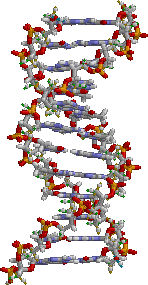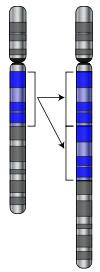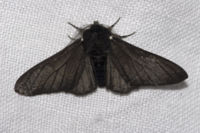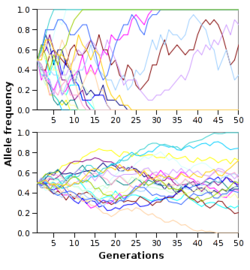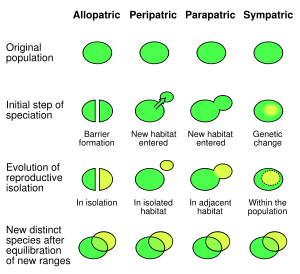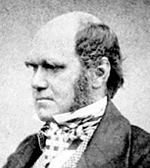Evolution
2008/9 Schools Wikipedia Selection. Related subjects: Evolution and reproduction
In biology, evolution is the process of change in the inherited traits of a population of organisms from one generation to the next. The genes that are passed on to an organism's offspring produce the inherited traits that are the basis of evolution. Mutations in genes can produce new or altered traits in individuals, resulting in the appearance of heritable differences between organisms, but new traits also come from the transfer of genes between populations, as in migration, or between species, in horizontal gene transfer. In species that reproduce sexually, new combinations of genes are produced by genetic recombination, which can increase the variation in traits between organisms. Evolution occurs when these heritable differences become more common or rare in a population.
There are two major mechanisms driving evolution. The first is natural selection, a process causing heritable traits that are helpful for survival and reproduction to become more common in a population, and harmful traits to become more rare. This occurs because individuals with advantageous traits are more likely to reproduce, so that more individuals in the next generation inherit these traits. Over many generations, adaptations occur through a combination of successive, small, random changes in traits, and natural selection of those variants best-suited for their environment. The second is genetic drift, an independent process that produces random changes in the frequency of traits in a population. Genetic drift results from the role probability plays in whether a given trait will be passed on as individuals survive and reproduce. Though the changes produced in any one generation by drift and selection are small, differences accumulate with each subsequent generation and can, over time, cause substantial changes in the organisms.
One definition of a species is a group of organisms that can reproduce with one another and produce fertile offspring. When a species is separated into populations that are prevented from interbreeding, mutations, genetic drift, and natural selection cause the accumulation of differences over generations and the emergence of new species. The similarities between organisms suggest that all known species are descended from a common ancestor (or ancestral gene pool) through this process of gradual divergence.
Evolutionary biology documents the fact that evolution occurs, and also develops and tests theories that explain why it occurs. Studies of the fossil record and the diversity of living organisms had convinced most scientists by the mid-nineteenth century that species changed over time. However, the mechanism driving these changes remained unclear until the 1859 publication of Charles Darwin's On the Origin of Species, detailing the theory of evolution by natural selection. Darwin's work soon led to overwhelming acceptance of evolution within the scientific community. In the 1930s, Darwinian natural selection was combined with Mendelian inheritance to form the modern evolutionary synthesis, in which the connection between the units of evolution (genes) and the mechanism of evolution (natural selection) was made. This powerful explanatory and predictive theory directs research by constantly raising new questions, and it has become the central organizing principle of modern biology, providing a unifying explanation for the diversity of life on Earth.
Heredity
Evolution in organisms occurs through changes in discrete traits – particular characteristics of an organism. In humans, for example, eye colour is an inherited characteristic, which individuals can inherit from one of their parents. Inherited traits are controlled by genes and the complete set of genes within an organism's genome is called its genotype.
The complete set of observable traits that make up the structure and behaviour of an organism is called its phenotype. These traits come from the interaction of its genotype with the environment. As a result, not every aspect of an organism's phenotype is inherited. Suntanned skin results from the interaction between a person's genotype and sunlight; thus, suntans are not passed on to people's children. However, people have different responses to sunlight, arising from differences in their genotype; a striking example is individuals with the inherited trait of albinism, who do not tan and are highly sensitive to sunburn.
Heritable traits are propagated between generations via DNA, a molecule which is capable of encoding genetic information. DNA is a polymer composed of four types of bases. The sequence of bases along a particular DNA molecule specify the genetic information, in a manner akin to a sequence of letters specifying a text or a sequence of bits specifying a computer program. Portions of a DNA molecule that specify a single functional unit are called genes; different genes have different sequences of bases. Within cells, the long strands of DNA associate with proteins to form condensed structures called chromosomes. A specific location within a chromosome is known as a locus. If the DNA sequence at a locus varies between individuals, the different forms of this sequence are called alleles. DNA sequences can change through mutations, producing new alleles. If a mutation occurs within a gene, the new allele may affect the trait that the gene controls, altering the phenotype of the organism. However, while this simple correspondence between an allele and a trait works in some cases, most traits are more complex and are controlled by multiple interacting genes.
Variation
An individual organisms phenotype results from both its genotype and the influence from the environment it has lived in. A substantial part of the variation in phenotypes in a population is caused by the differences between their genotypes. The modern evolutionary synthesis defines evolution as the change over time in this genetic variation. The frequency of one particular allele will fluctuate, becoming more or less prevalent relative to other forms of that gene. Evolutionary forces act by driving these changes in allele frequency in one direction or another. Variation disappears when an allele reaches the point of fixation — when it either disappears from the population or replaces the ancestral allele entirely.
Variation comes from mutations in genetic material, migration between populations ( gene flow), and the reshuffling of genes through sexual reproduction. Variation also comes from exchanges of genes between different species; for example, through horizontal gene transfer in bacteria, and hybridization in plants. Despite the constant introduction of variation through these processes, most of the genome of a species is identical in all individuals of that species. However, even relatively small changes in genotype can lead to dramatic changes in phenotype: chimpanzees and humans differ in only about 5% of their genomes.
Mutation
Genetic variation comes from random mutations that occur in the genomes of organisms. Mutations are changes in the DNA sequence of a cell's genome and are caused by radiation, viruses, transposons and mutagenic chemicals, as well as errors that occur during meiosis or DNA replication. These mutagens produce several different types of change in DNA sequences; these can either have no effect, alter the product of a gene, or prevent the gene from functioning. Studies in the fly Drosophila melanogaster suggest that if a mutation changes a protein produced by a gene, this will probably be harmful, with about 70 percent of these mutations having damaging effects, and the remainder being either neutral or weakly beneficial. Due to the damaging effects that mutations can have on cells, organisms have evolved mechanisms such as DNA repair to remove mutations. Therefore, the optimal mutation rate for a species is a trade-off between costs of a high mutation rate, such as deleterious mutations, and the metabolic costs of maintaining systems to reduce the mutation rate, such as DNA repair enzymes. Some species such as retroviruses have such high mutation rates that most of their offspring will possess a mutated gene. Such rapid mutation may have been selected so that these viruses can constantly and rapidly evolve, and thus evade the responses of the human immune system.
Mutations can involve large sections of DNA becoming duplicated, which is a major source of raw material for evolving new genes, with tens to hundreds of genes duplicated in animal genomes every million years. Most genes belong to larger families of genes of shared ancestry. Novel genes are produced either through duplication and mutation of an ancestral gene, or by recombining parts of different genes to form new combinations with new functions. For example, the human eye uses four genes to make structures that sense light: three for colour vision and one for night vision; all four arose from a single ancestral gene. An advantage of duplicating a gene (or even an entire genome) is that overlapping or redundant functions in multiple genes allows alleles to be retained that would otherwise be harmful, thus increasing genetic diversity.
Changes in chromosome number may involve even larger mutations, where long segments of the DNA within chromosomes breaks and then rearranges. For example, two chromosomes in the Homo genus fused to produce human chromosome 2; this fusion did not occur in the lineage of the other apes, and they retain these separate chromosomes. In evolution, the most important role of such chromosomal rearrangements may be to accelerate the divergence of a population into new species by making populations less likely to interbreed, and thereby preserving genetic differences between these populations.
Sequences of DNA that can move about the genome, such as transposons, make up a major fraction of the genetic material of plants and animals, and may have been important in the evolution of genomes. For example, more than a million copies of the Alu sequence are present in the human genome, and these sequences have now been recruited to perform functions such as regulating gene expression. Another effect of these mobile DNA sequences is that when they move within a genome, they can mutate or delete existing genes and thereby produce genetic diversity.
Sex and recombination
In asexual organisms, genes are inherited together, or linked, as they cannot mix with genes in other organisms during reproduction. However, the offspring of sexual organisms contain random mixtures of their parents' chromosomes that are produced through independent assortment. In the related process of genetic recombination, sexual organisms can also exchange DNA between two matching chromosomes. Recombination and reassortment do not alter allele frequencies, but instead change which alleles are associated with each other, producing offspring with new combinations of alleles. While this process increases the variation in any individual's offspring, genetic mixing can be predicted to either have no effect, increase, or decrease the genetic variation in the population, depending on how the various alleles in the population are distributed. For example, if two alleles are randomly distributed in a population, then sex will have no effect on variation; however, if two alleles tend to be found as a pair, then genetic mixing will even out this non-random distribution and over time make the organisms in the population more similar to each other. The overall effect of sex on natural variation remains unclear, but recent research suggests that sex usually increases genetic variation and may increase the rate of evolution.
Recombination allows even alleles that are close together in a strand of DNA to be inherited independently. However, the rate of recombination is low, since in humans in a stretch of DNA one million base pairs long there is about a one in a hundred chance of a recombination event occurring per generation. As a result, genes close together on a chromosome may not always be shuffled away from each other, and genes that are close together tend to be inherited together. This tendency is measured by finding how often two alleles occur together, which is called their linkage disequilibrium. A set of alleles that is usually inherited in a group is called a haplotype.
Sexual reproduction helps to remove harmful mutations and retain beneficial mutations. Consequently, when alleles cannot be separated by recombination – such as in mammalian Y chromosomes, which pass intact from fathers to sons – harmful mutations accumulate. In addition, recombination and reassortment can produce individuals with new and advantageous gene combinations. These positive effects are balanced by the fact that this process can cause mutations and separate beneficial combinations of genes.
Population genetics
From a genetic viewpoint, evolution is a generation-to-generation change in the frequencies of alleles within a population that shares a common gene pool. A population is a localized group of individuals belonging to the same species. For example, all of the moths of the same species living in an isolated forest represent a population. A single gene in this population may have several alternate forms, which account for variations between the phenotypes of the organisms. An example might be a gene for coloration in moths that has two alleles: black and white. A gene pool is the complete set of alleles in a single population, so each allele occurs a certain number of times in a gene pool. The fraction of genes within the gene pool that are a particular allele is called the allele frequency. Evolution occurs when there are changes in the frequencies of alleles within a population of interbreeding organisms; for example the allele for black colour in a population of moths becoming more common.
To understand the mechanisms that cause a population to evolve, it is useful to consider what conditions are required for a population not to evolve. The Hardy-Weinberg principle states that the frequencies of alleles (variations in a gene) in a sufficiently large population will remain constant if the only forces acting on that population are the random reshuffling of alleles during the formation of the sperm or egg, and the random combination of the alleles in these sex cells during fertilization. Such a population is said to be in Hardy-Weinberg equilibrium - it is not evolving.
Mechanisms
There are three basic mechanisms of evolutionary change: natural selection, genetic drift, and gene flow. Natural selection favors genes that improve capacity for survival and reproduction. Genetic drift is random change in the frequency of alleles, caused by the random sampling of a generation's genes during reproduction, and gene flow is the transfer of genes within and between populations. The relative importance of natural selection and genetic drift in a population varies depending on the strength of the selection and the effective population size, which is the number of individuals capable of breeding. Natural selection usually predominates in large populations, while genetic drift dominates in small populations. The dominance of genetic drift in small populations can even lead to the fixation of slightly deleterious mutations. As a result, changing population size can dramatically influence the course of evolution. Population bottlenecks, where the population shrinks temporarily and therefore loses genetic variation, result in a more uniform population. Bottlenecks also result from alterations in gene flow such as decreased migration, expansions into new habitats, or population subdivision.
Natural selection
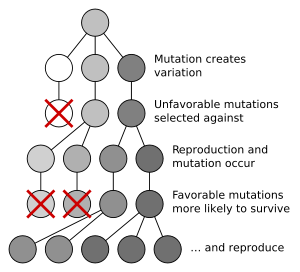
Natural selection is the process by which genetic mutations that enhance reproduction become, and remain, more common in successive generations of a population. It has often been called a "self-evident" mechanism because it necessarily follows from three simple facts:
- Heritable variation exists within populations of organisms.
- Organisms produce more offspring than can survive.
- These offspring vary in their ability to survive and reproduce.
These conditions produce competition between organisms for survival and reproduction. Consequently, organisms with traits that give them an advantage over their competitors pass these advantageous traits on, while traits that do not confer an advantage are not passed on to the next generation.
The central concept of natural selection is the evolutionary fitness of an organism. This measures the organism's genetic contribution to the next generation. However, this is not the same as the total number of offspring: instead fitness measures the proportion of subsequent generations that carry an organism's genes. Consequently, if an allele increases fitness more than the other alleles of that gene, then with each generation this allele will become more common within the population. These traits are said to be "selected for". Examples of traits that can increase fitness are enhanced survival, and increased fecundity. Conversely, the lower fitness caused by having a less beneficial or deleterious allele results in this allele becoming rarer — they are "selected against". Importantly, the fitness of an allele is not a fixed characteristic, if the environment changes, previously neutral or harmful traits may become beneficial and previously beneficial traits become harmful..
Natural selection within a population for a trait that can vary across a range of values, such as height, can be categorized into three different types. The first is directional selection, which is a shift in the average value of a trait over time — for example organisms slowly getting taller. Secondly, disruptive selection is selection for extreme trait values and often results in two different values becoming most common, with selection against the average value. This would be when either short or tall organisms had an advantage, but not those of medium height. Finally, in stabilizing selection there is selection against extreme trait values on both ends, which causes a decrease in variance around the average value. This would, for example, cause organisms to slowly become all the same height.
A special case of natural selection is sexual selection, which is selection for any trait that increases mating success by increasing the attractiveness of an organism to potential mates. Traits that evolved through sexual selection are particularly prominent in males of some animal species, despite traits such as cumbersome antlers, mating calls or bright colors that attract predators, decreasing the survival of individual males. This survival disadvantage is balanced by higher reproductive success in males that show these hard to fake, sexually selected traits.
An active area of research is the unit of selection, with natural selection being proposed to work at the level of genes, cells, individual organisms, groups of organisms and even species. None of these models are mutually-exclusive and selection may act on multiple levels simultaneously. Below the level of the individual, genes called transposons try to copy themselves throughout the genome. Selection at a level above the individual, such as group selection, may allow the evolution of co-operation, as discussed below.
Genetic drift
Genetic drift is the change in allele frequency from one generation to the next that occurs because alleles in offspring are a random sample of those in the parents, as well as from the role that chance plays in determining whether a given individual will survive and reproduce. In mathematical terms, alleles are subject to sampling error. As a result, when selective forces are absent or relatively weak, allele frequencies tend to "drift" upward or downward randomly (in a random walk). This drift halts when an allele eventually becomes fixed, either by disappearing from the population, or replacing the other alleles entirely. Genetic drift may therefore eliminate some alleles from a population due to chance alone. Even in the absence of selective forces, genetic drift can cause two separate populations which began with the same genetic structure to drift apart into two divergent populations with different sets of alleles.
The time for an allele to become fixed by genetic drift depends on population size, with fixation occurring more rapidly in smaller populations. The precise measure of populations that is important here is called the effective population size, which was defined by Sewall Wright as a theoretical number representing the number of breeding individuals that would exhibit the same observed degree of inbreeding.
Although natural selection is responsible for adaptation, the relative importance of the two forces of natural selection and genetic drift in driving evolutionary change in general is an area of current research in evolutionary biology. These investigations were prompted by the neutral theory of molecular evolution, which proposed that most evolutionary changes are the result of the fixation of neutral mutations that do not have any immediate effects on the fitness of an organism. Hence, in this model, most genetic changes in a population are the result of constant mutation pressure and genetic drift.
Gene flow
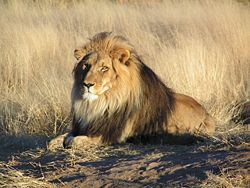
Gene flow is the exchange of genes between populations, which are usually of the same species. Examples of gene flow within a species include the migration and then breeding of organisms, or the exchange of pollen. Gene transfer between species includes the formation of hybrid organisms and horizontal gene transfer.
Migration into or out of a population can change allele frequencies, as well as introducing genetic variation into a population. Immigration may add new genetic material to the established gene pool of a population. Conversely, emigration may remove genetic material. As barriers to reproduction between two diverging populations are required for the populations to become new species, gene flow may slow this process by spreading genetic differences between the populations. Gene flow is hindered by mountain ranges, oceans and deserts or even man-made structures such as the Great Wall of China, which has hindered the flow of plant genes.
Depending on how far two species have diverged since their most recent common ancestor, it may still be possible for them to produce offspring, as with horses and donkeys mating to produce mules. Such hybrids are generally infertile, due to the two different sets of chromosomes being unable to pair up during meiosis. In this case, closely-related species may regularly interbreed, but hybrids will be selected against and the species will remain distinct. However, viable hybrids are occasionally formed and these new species can either have properties intermediate between their parent species, or possess a totally new phenotype. The importance of hybridization in creating new species of animals is unclear, although cases have been seen in many types of animals, with the gray tree frog being a particularly well-studied example.
Hybridization is, however, an important means of speciation in plants, since polyploidy (having more than two copies of each chromosome) is tolerated in plants more readily than in animals. Polyploidy is important in hybrids as it allows reproduction, with the two different sets of chromosomes each being able to pair with an identical partner during meiosis. Polyploids also have more genetic diversity, which allows them to avoid inbreeding depression in small populations.
Horizontal gene transfer is the transfer of genetic material from one organism to another organism that is not its offspring; this is most common among bacteria. In medicine, this contributes to the spread of antibiotic resistance, as when one bacteria acquires resistance genes it can rapidly transfer them to other species. Horizontal transfer of genes from bacteria to eukaryotes such as the yeast Saccharomyces cerevisiae and the adzuki bean beetle Callosobruchus chinensis may also have occurred. An example of larger-scale transfers are the eukaryotic bdelloid rotifers, which appear to have received a range of genes from bacteria, fungi, and plants. Viruses can also carry DNA between organisms, allowing transfer of genes even across biological domains. Large-scale gene transfer has also occurred between the ancestors of eukaryotic cells and prokaryotes, during the acquisition of chloroplasts and mitochondrial.
Outcomes
Evolution influences every aspect of the form and behavior of organisms. Most prominent are the specific behavioural and physical adaptations that are the outcome of natural selection. These adaptations increase fitness by aiding activities such as finding food, avoiding predators or attracting mates. Organisms can also respond to selection by co-operating with each other, usually by aiding their relatives or engaging in mutually-beneficial symbiosis. In the longer term, evolution produces new species through splitting ancestral populations of organisms into new groups that cannot or will not interbreed.
These outcomes of evolution are sometimes divided into macroevolution, which is evolution that occurs at or above the level of species, such as speciation, and microevolution, which is smaller evolutionary changes, such as adaptations, within a species or population. In general, macroevolution is the outcome of long periods of microevolution. Thus, the distinction between micro- and macroevolution is not a fundamental one - the difference is simply the time involved. However, in macroevolution, the traits of the entire species are important. For instance, a large amount of variation among individuals allows a species to rapidly adapt to new habitats, lessening the chance of it going extinct, while a wide geographic range increases the chance of speciation, by making it more likely that part of the population will become isolated. In this sense, microevolution and macroevolution can sometimes be separate.
A common misconception is that evolution is "progressive," but natural selection has no long-term goal and does not necessarily produce greater complexity. Although complex species have evolved, this occurs as a side effect of the overall number of organisms increasing, and simple forms of life remain more common. For example, the overwhelming majority of species are microscopic prokaryotes, which form about half the world's biomass despite their small size, and constitute the vast majority of Earth's biodiversity. Simple organisms have therefore been the dominant form of life on Earth throughout its history and continue to be the main form of life up to the present day, with complex life only appearing more diverse because it is more noticeable.
Adaptation
Adaptations are structures or behaviors that enhance a specific function, causing organisms to become better at surviving and reproducing. They are produced by a combination of the continuous production of small, random changes in traits, followed by natural selection of the variants best-suited for their environment. This process can cause either the gain of a new feature, or the loss of an ancestral feature. An example that shows both types of change is bacterial adaptation to antibiotic selection, with genetic changes causing antibiotic resistance by both modifying the target of the drug, or increasing the activity of transporters that pump the drug out of the cell. Other striking examples are the bacteria Escherichia coli evolving the ability to use citric acid as a nutrient in a long-term laboratory experiment, or Flavobacterium evolving a novel enzyme that allows these bacteria to grow on the by-products of nylon manufacturing.
However, many traits that appear to be simple adaptations are in fact exaptations: structures originally adapted for one function, but which coincidentally became somewhat useful for some other function in the process. One example is the African lizard Holapsis guentheri, which developed an extremely flat head for hiding in crevices, as can be seen by looking at its near relatives. However, in this species, the head has become so flattened that it assists in gliding from tree to tree—an exaptation. Another is the recruitment of enzymes from glycolysis and xenobiotic metabolism to serve as structural proteins called crystallins within the lenses of organisms' eyes.

As adaptation occurs through the gradual modification of existing structures, structures with similar internal organization may have very different functions in related organisms. This is the result of a single ancestral structure being adapted to function in different ways. The bones within bat wings, for example, are structurally similar to both human hands and seal flippers, due to the common descent of these structures from an ancestor that also had five digits at the end of each forelimb. Other idiosyncratic anatomical features, such as bones in the wrist of the panda being formed into a false "thumb," indicate that an organism's evolutionary lineage can limit what adaptations are possible.
During adaptation, some structures may lose their original function and become vestigial structures. Such structures may have little or no function in a current species, yet have a clear function in ancestral species, or other closely-related species. Examples include pseudogenes, the non-functional remains of eyes in blind cave-dwelling fish, wings in flightless birds, and the presence of hip bones in whales and snakes. Examples of vestigial structures in humans include wisdom teeth, the coccyx, and the vermiform appendix.
An area of current investigation in evolutionary developmental biology is the developmental basis of adaptations and exaptations. This research addresses the origin and evolution of embryonic development and how modifications of development and developmental processes produce novel features. These studies have shown that evolution can alter development to create new structures, such as embryonic bone structures that develop into the jaw in other animals instead forming part of the middle ear in mammals. It is also possible for structures that have been lost in evolution to reappear due to changes in developmental genes, such as a mutation in chickens causing embryos to grow teeth similar to those of crocodiles.
Co-evolution
Interactions between organisms can produce both conflict and co-operation. When the interaction is between pairs of species, such as a pathogen and a host, or a predator and its prey, these species can develop matched sets of adaptations. Here, the evolution of one species causes adaptations in a second species. These changes in the second species then, in turn, cause new adaptations in the first species. This cycle of selection and response is called co-evolution. An example is the production of tetrodotoxin in the rough-skinned newt and the evolution of tetrodotoxin resistance in its predator, the common garter snake. In this predator-prey pair, an evolutionary arms race has produced high levels of toxin in the newt and correspondingly high levels of resistance in the snake.
Co-operation
However, not all interactions between species involve conflict. Many cases of mutually beneficial interactions have evolved. For instance, an extreme cooperation exists between plants and the mycorrhizal fungi that grow on their roots and aid the plant in absorbing nutrients from the soil. This is a reciprocal relationship as the plants provide the fungi with sugars from photosynthesis. Here, the fungi actually grow inside plant cells, allowing them to exchange nutrients with their hosts, while sending signals that suppress the plant immune system.
Coalitions between organisms of the same species have also evolved. An extreme case is the eusociality found in social insects, such as bees, termites and ants, where sterile insects feed and guard the small number of organisms in a colony that are able to reproduce. On an even smaller scale, the somatic cells that make up the body of an animal limit their reproduction so they can maintain a stable organism, which then supports a small number of the animal's germ cells to produce offspring. Here, somatic cells respond to specific signals that instruct them to either grow or kill themselves. If cells ignore these signals and attempt to multiply inappropriately, their uncontrolled growth causes cancer.
These examples of cooperation within species are thought to have evolved through the process of kin selection, which is where one organism acts to help raise a relative's offspring. This activity is selected for because if the helping individual contains alleles which promote the helping activity, it is likely that its kin will also contain these alleles and thus those alleles will be passed on. Other processes that may promote cooperation include group selection, where cooperation provides benefits to a group of organisms.
Speciation
Speciation is the process where a species diverges into two or more descendant species. It has been observed multiple times under both controlled laboratory conditions and in nature. In sexually-reproducing organisms, speciation results from reproductive isolation followed by genealogical divergence. There are four mechanisms for speciation. The most common in animals is allopatric speciation, which occurs in populations initially isolated geographically, such as by habitat fragmentation or migration. Selection under these conditions can produce very rapid changes in the appearance and behaviour of organisms. As selection and drift act independently on populations isolated from the rest of their species, separation may eventually produce organisms that cannot interbreed.
The second mechanism of speciation is peripatric speciation, which occurs when small populations of organisms become isolated in a new environment. This differs from allopatric speciation in that the isolated populations are numerically much smaller than the parental population. Here, the founder effect causes rapid speciation through both rapid genetic drift and selection on a small gene pool.
The third mechanism of speciation is parapatric speciation. This is similar to peripatric speciation in that a small population enters a new habitat, but differs in that there is no physical separation between these two populations. Instead, speciation results from the evolution of mechanisms that reduce gene flow between the two populations. Generally this occurs when there has been a drastic change in the environment within the parental species' habitat. One example is the grass Anthoxanthum odoratum, which can undergo parapatric speciation in response to localized metal pollution from mines. Here, plants evolve that have resistance to high levels of metals in the soil. Selection against interbreeding with the metal-sensitive parental population produces a change in flowering time of the metal-resistant plants, causing reproductive isolation. Selection against hybrids between the two populations may cause reinforcement, which is the evolution of traits that promote mating within a species, as well as character displacement, which is when two species become more distinct in appearance.

Finally, in sympatric speciation species diverge without geographic isolation or changes in habitat. This form is rare since even a small amount of gene flow may remove genetic differences between parts of a population. Generally, sympatric speciation in animals requires the evolution of both genetic differences and non-random mating, to allow reproductive isolation to evolve.
One type of sympatric speciation involves cross-breeding of two related species to produce a new hybrid species. This is not common in animals as animal hybrids are usually sterile, because during meiosis the homologous chromosomes from each parent, being from different species cannot successfully pair. It is more common in plants, however because plants often double their number of chromosomes, to form polyploids. This allows the chromosomes from each parental species to form a matching pair during meiosis, as each parent's chromosomes is represented by a pair already. An example of such a speciation event is when the plant species Arabidopsis thaliana and Arabidopsis arenosa cross-bred to give the new species Arabidopsis suecica. This happened about 20,000 years ago, and the speciation process has been repeated in the laboratory, which allows the study of the genetic mechanisms involved in this process. Indeed, chromosome doubling within a species may be a common cause of reproductive isolation, as half the doubled chromosomes will be unmatched when breeding with undoubled organisms.
Speciation events are important in the theory of punctuated equilibrium, which accounts for the pattern in the fossil record of short "bursts" of evolution interspersed with relatively long periods of stasis, where species remain relatively unchanged. In this theory, speciation and rapid evolution are linked, with natural selection and genetic drift acting most strongly on organisms undergoing speciation in novel habitats or small populations. As a result, the periods of stasis in the fossil record correspond to the parental population, and the organisms undergoing speciation and rapid evolution are found in small populations or geographically-restricted habitats, and therefore rarely being preserved as fossils.
Extinction
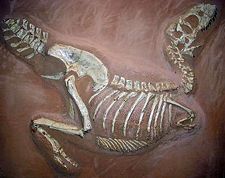
Extinction is the disappearance of an entire species. Extinction is not an unusual event, as species regularly appear through speciation, and disappear through extinction. Indeed, virtually all animal and plant species that have lived on earth are now extinct. These extinctions have happened continuously throughout the history of life, although the rate of extinction spikes in occasional mass extinction events. The Cretaceous–Tertiary extinction event, during which the dinosaurs went extinct, is the most well-known, but the earlier Permian–Triassic extinction event was even more severe, with approximately 96 percent of species driven to extinction. The Holocene extinction event is an ongoing mass extinction associated with humanity's expansion across the globe over the past few thousand years. Present-day extinction rates are 100-1000 times greater than the background rate, and up to 30 percent of species may be extinct by the mid 21st century. Human activities are now the primary cause of the ongoing extinction event; global warming may further accelerate it in the future.
The role of extinction in evolution depends on which type is considered. The causes of the continuous "low-level" extinction events, which form the majority of extinctions, are not well understood and may be the result of competition between species for limited resources ( competitive exclusion). If competition from other species does alter the probability that a species will become extinct, this could produce species selection as a level of natural selection. The intermittent mass extinctions are also important, but instead of acting as a selective force, they drastically reduce diversity in a nonspecific manner and promote bursts of rapid evolution and speciation in survivors.
Evolutionary history of life
Origin of life
The origin of life is a necessary precursor for biological evolution, but understanding that evolution occurred once organisms appeared and investigating how this happens, does not depend on understanding exactly how life began. The current scientific consensus is that the complex biochemistry that makes up life came from simpler chemical reactions, but it is unclear how this occurred. Not much is certain about the earliest developments in life, the structure of the first living things, or the identity and nature of any last universal common ancestor or ancestral gene pool. Consequently, there is no scientific consensus on how life began, but proposals include self-replicating molecules such as RNA, and the assembly of simple cells.
Common descent
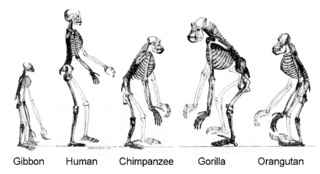
All organisms on Earth are descended from a common ancestor or ancestral gene pool. Current species are a stage in the process of evolution, with their diversity the product of a long series of speciation and extinction events. The common descent of organisms was first deduced from four simple facts about organisms: First, they have geographic distributions that cannot be explained by local adaptation. Second, the diversity of life is not a set of completely unique organisms, but organisms that share morphological similarities. Third, vestigial traits with no clear purpose resemble functional ancestral traits, and finally, that organisms can be classified using these similarities into a hierarchy of nested groups.
Past species have also left records of their evolutionary history. Fossils, along with the comparative anatomy of present-day organisms, constitute the morphological, or anatomical, record. By comparing the anatomies of both modern and extinct species, paleontologists can infer the lineages of those species. However, this approach is most successful for organisms that had hard body parts, such as shells, bones or teeth. Further, as prokaryotes such as bacteria and archaea share a limited set of common morphologies, their fossils do not provide information on their ancestry.
More recently, evidence for common descent has come from the study of biochemical similarities between organisms. For example, all living cells use the same nucleic acids and amino acids. The development of molecular genetics has revealed the record of evolution left in organisms' genomes: dating when species diverged through the molecular clock produced by mutations. For example, these DNA sequence comparisons have revealed the close genetic similarity between humans and chimpanzees and shed light on when the common ancestor of these species existed.
Evolution of life
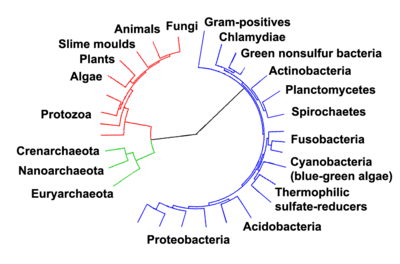
Despite the uncertainty on how life began, it is clear that prokaryotes were the first organisms to inhabit Earth, approximately 3–4 billion years ago. No obvious changes in morphology or cellular organization occurred in these organisms over the next few billion years.
The eukaryotes were the next major innovation in evolution. These came from ancient bacteria being engulfed by the ancestors of eukaryotic cells, in a cooperative association called endosymbiosis. The engulfed bacteria and the host cell then underwent co-evolution, with the bacteria evolving into either mitochondria or hydrogenosomes. An independent second engulfment of cyanobacterial-like organisms led to the formation of chloroplasts in algae and plants.
The history of life was that of the unicellular eukaryotes, prokaryotes, and archaea until about a billion years ago when multicellular organisms began to appear in the oceans in the Ediacaran period. The evolution of multicellularity occurred in multiple independent events, in organisms as diverse as sponges, brown algae, cyanobacteria, slime moulds and myxobacteria.
Soon after the emergence of these first multicellular organisms, a remarkable amount of biological diversity appeared over approximately 10 million years, in an event called the Cambrian explosion. Here, the majority of types of modern animals appeared in the fossil record, as well as unique lineages that subsequently became extinct. Various triggers for the Cambrian explosion have been proposed, including the accumulation of oxygen in the atmosphere from photosynthesis. About 500 million years ago, plants and fungi colonized the land, and were soon followed by arthropods and other animals. Amphibians first appeared around 300 million years ago, followed by early amniotes, then mammals around 200 million years ago and birds around 100 million years ago (both from "reptile"-like lineages). However, despite the evolution of these large animals, smaller organisms similar to the types that evolved early in this process continue to be highly successful and dominate the Earth, with the majority of both biomass and species being prokaryotes.
History of evolutionary thought
Evolutionary ideas such as common descent and the transmutation of species have existed since at least the 6th century BC, when they were expounded by the Greek philosopher Anaximander. Others who considered such ideas included the Greek philosopher Empedocles, the Roman philosopher-poet Lucretius, the Arab biologist Al-Jahiz, the Persian philosopher Ibn Miskawayh, the Brethren of Purity, and the Eastern philosopher Zhuangzi. As biological knowledge grew in the 18th century, evolutionary ideas were set out by a few natural philosophers including Pierre Maupertuis in 1745 and Erasmus Darwin in 1796. The ideas of the biologist Jean-Baptiste Lamarck about transmutation of species had wide influence. Charles Darwin formulated his idea of natural selection in 1838 and was still developing his theory in 1858 when Alfred Russel Wallace sent him a similar theory, and both were presented to the Linnean Society of London in separate papers. At the end of 1859 Darwin's publication of On the Origin of Species explained natural selection in detail and presented evidence leading to increasingly wide acceptance of the occurrence of evolution.
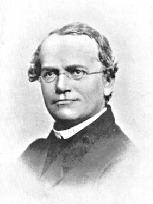
Debate about the mechanisms of evolution continued, and Darwin could not explain the source of the heritable variations which would be acted on by natural selection. Like Lamarck, he thought that parents passed on adaptations acquired during their lifetimes, a theory which was subsequently dubbed Lamarckism. In the 1880s August Weismann's experiments indicated that changes from use and disuse were not heritable, and Lamarckism gradually fell from favour. More significantly, Darwin could not account for how traits were passed down from generation to generation. In 1865 Gregor Mendel found that traits were inherited in a predictable manner. When Mendel's work was rediscovered in 1900, disagreements over the rate of evolution predicted by early geneticists and biometricians led to a rift between the Mendelian and Darwinian models of evolution.
This contradiction was reconciled in the 1930s by biologists such as Ronald Fisher. The end result was a combination of evolution by natural selection and Mendelian inheritance, the modern evolutionary synthesis. In the 1940s, the identification of DNA as the genetic material by Oswald Avery and colleagues and the subsequent publication of the structure of DNA by James Watson and Francis Crick in 1953, demonstrated the physical basis for inheritance. Since then, genetics and molecular biology have become core parts of evolutionary biology and have revolutionized the field of phylogenetics.
In its early history, evolutionary biology primarily drew in scientists from traditional taxonomically-oriented disciplines, whose specialist training in particular organisms addressed general questions in evolution. As evolutionary biology expanded as an academic discipline, particularly after the development of the modern evolutionary synthesis, it began to draw more widely from the biological sciences. Currently the study of evolutionary biology involves scientists from fields as diverse as biochemistry, ecology, genetics and physiology, and evolutionary concepts are used in even more distant disciplines such as psychology, medicine, philosophy and computer science.
Social and cultural responses
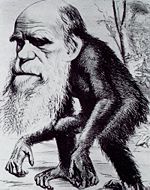
Even before the publication of On the Origin of Species, the idea that life had evolved was an active source of debate. Evolution is still a contentious concept in some quarters outside the scientific community. Debate has centered on the philosophical, social and religious implications of evolution, not on the science itself; the proposition that biological evolution occurs through the mechanism of natural selection is standard in the scientific literature.
Although many religions and denominations have reconciled their beliefs with evolution through various concepts of theistic evolution, there are many creationists who believe that evolution is contradicted by the creation myths found in their respective religions. As Darwin recognized early on, the most controversial aspect of evolutionary thought is its implications for human origins. In some countries—notably the United States—these tensions between scientific and religious teachings have fueled the ongoing creation–evolution controversy, a religious conflict focusing on politics and public education. While other scientific fields such as cosmology and earth science also conflict with literal interpretations of many religious texts, evolutionary biology experiences significantly more opposition from many religious believers.
Evolution has been used to support philosophical positions that promote discrimination and racism. For example, the eugenic ideas of Francis Galton were developed to argue that the human gene pool should be improved by selective breeding policies, including incentives for those considered "good stock" to reproduce, and the compulsory sterilization, prenatal testing, birth control, and even killing, of those considered "bad stock." Another example of an extension of evolutionary theory that is now widely regarded as unwarranted is " Social Darwinism," a term given to the 19th century Whig Malthusian theory developed by Herbert Spencer into ideas about " survival of the fittest" in commerce and human societies as a whole, and by others into claims that social inequality, racism, and imperialism were justified. However, contemporary scientists and philosophers consider these ideas to have been neither mandated by evolutionary theory nor supported by data.
Applications
A major technological application of evolution is artificial selection, which is the intentional selection of certain traits in a population of organisms. Humans have used artificial selection for thousands of years in the domestication of plants and animals. More recently, such selection has become a vital part of genetic engineering, with selectable markers such as antibiotic resistance genes being used to manipulate DNA in molecular biology.
As evolution can produce highly optimized processes and networks, it has many applications in computer science. Here, simulations of evolution using evolutionary algorithms and artificial life started with the work of Nils Aall Barricelli in the 1960s, and was extended by Alex Fraser, who published a series of papers on simulation of artificial selection. Artificial evolution became a widely recognized optimization method as a result of the work of Ingo Rechenberg in the 1960s and early 1970s, who used evolution strategies to solve complex engineering problems. Genetic algorithms in particular became popular through the writing of John Holland. As academic interest grew, dramatic increases in the power of computers allowed practical applications, including the automatic evolution of computer programs. Evolutionary algorithms are now used to solve multi-dimensional problems more efficiently than software produced by human designers, and also to optimize the design of systems.
Understanding evolution can have practical applications, as well. A certain species of coral might be discovered that produces an antibiotic compound with medical potential. Knowing its closest relatives would inform researchers of other species that might produce similar compounds, which could then be investigated.
